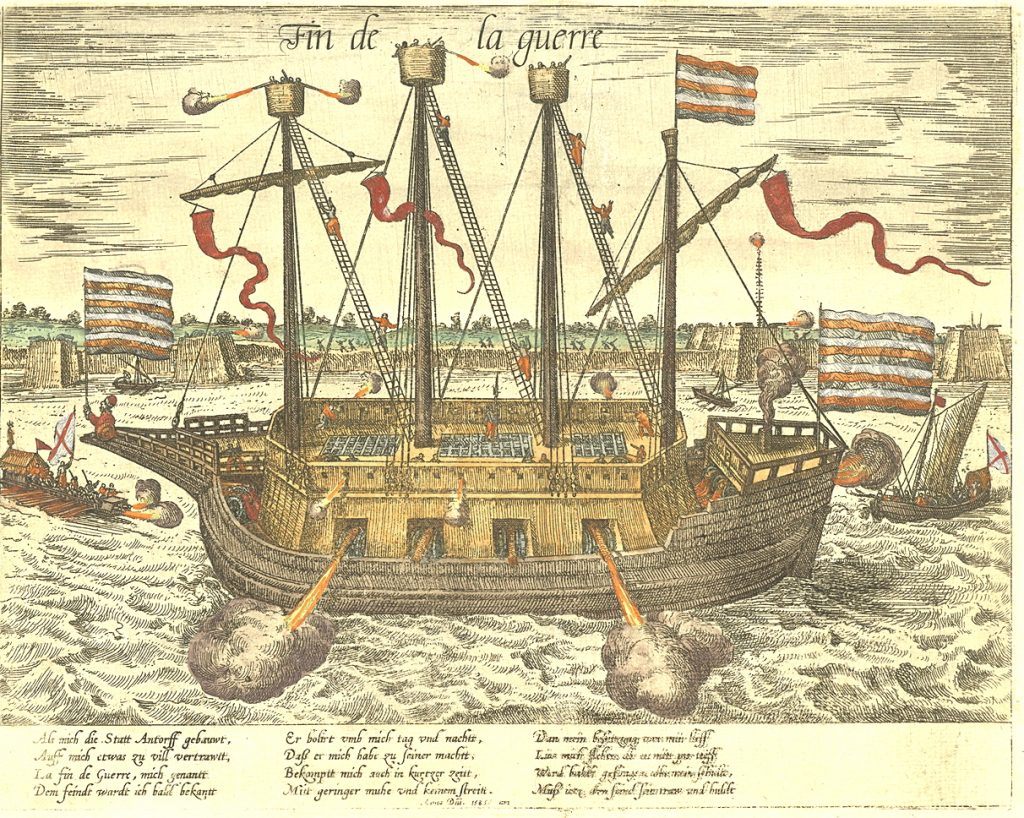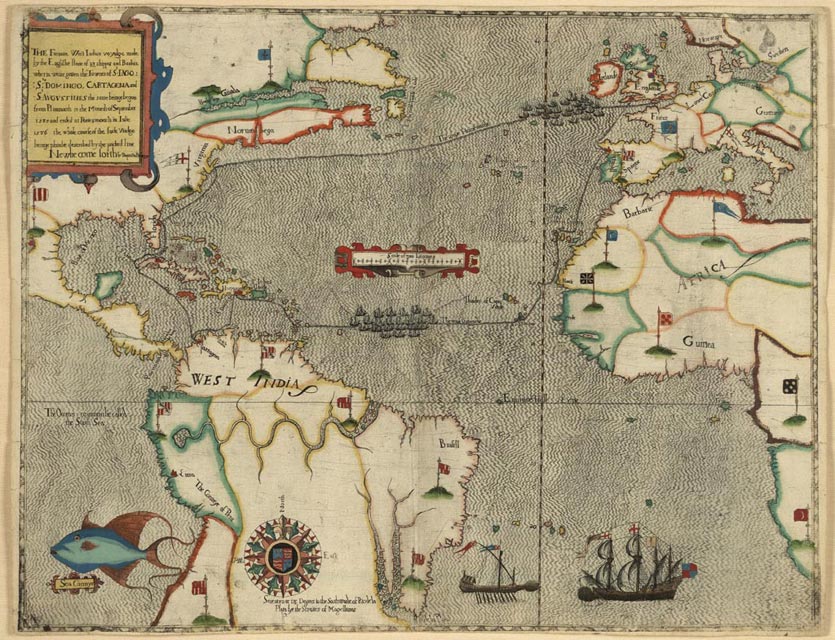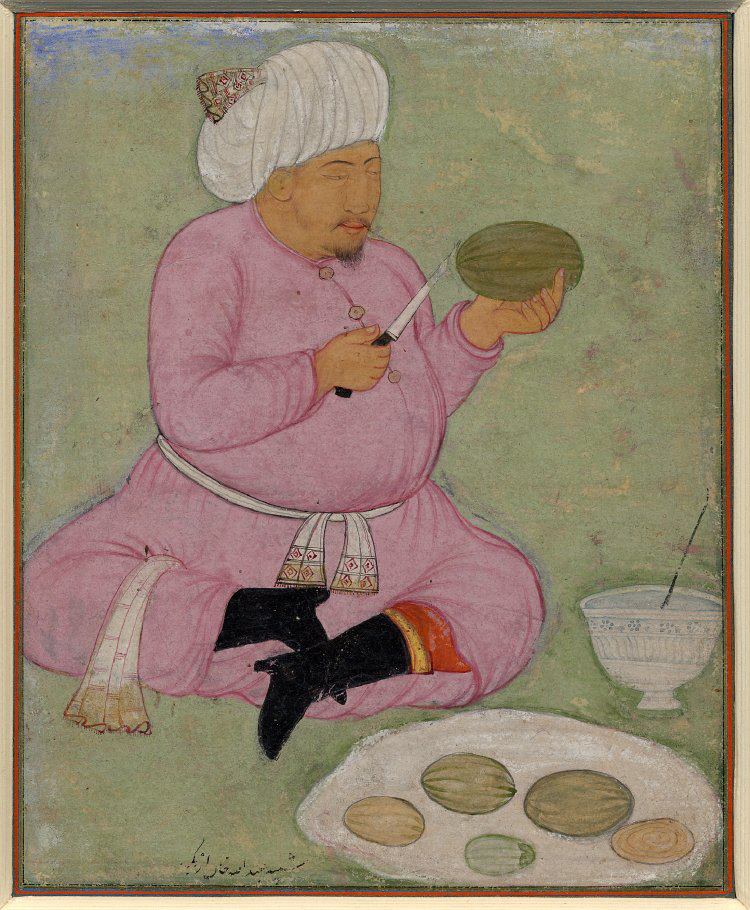For a change here, I’ll describe the year’s main events first, then come to the Akbar/Mughal sidebar later.
War between Spain and England
Different (and all well-sourced) Wikipedia pages give different accounts of the “precipitating event” for this war that would, over the 19 years to follow, do so much to shape the emergence of the “West” and thus the (im-)balance of power of the whole world. Let’s just say that with the political consolidation of a Protestant power in England that had considerable maritime capabilities and was determined not to bow before the Catholic imperatives of the Iberian Union, perhaps this conflict was over-determined already.
This WP page says:
The Anglo-Spanish War broke out in 1585, following the seizure of English merchant ships in Spanish harbors. In response the English privy council immediately authorised a campaign against the Spanish fishing industry in Newfoundland and off the Grand Banks. The campaign was a huge success, and subsequently led to England’s first sustained activity in the Americas. In August, England joined the [Spanish-Dutch] Eighty Years’ War on the side of the Dutch Protestant United Provinces, which had declared their independence from Spain.
(Two comments there. First, that was the first time I really considered access to distant fisheries as a possible driver of imperial expansion in this era– though I know that access to fisheries in general continues to be a non-trivial issues in intra-European politics today. Second, when England joined the Spanish-Dutch conflict in 1585 neither Elizabeth nor anyone else would have known this would be an “Eighty Years War”, so the use of that name there feels a bit weird.)
But still, a generally helpful summary there, though I would have put more emphasis on the developments in the Netherlands.
When we last looked at what was happening in the Netherlands, in 1581, the mainly-Protestant seven northern provinces had announced their secession from the Habsburg Empire as the “United Provinces” (UPs) and were looking around for some other monarchical figure to head them. In 1584, their own homegrown best contender for this role, William the Silent (also called William of Orange) was assassinated. On December 31, 1584, Spain had signed its anti-Protestant Treaty of Joinville with the Catholic League in France…
Then in February 1585, the expert Spanish military seized Brussels and headed further north, imposing a tight siege around the city of Antwerp which had long been the key financial and manufacturing center for the whole of northern Europe.
The English had all along been able to give the UPs a certain amount of valuable military and naval help in their battles against the Spanish. But in August 1585, a Queen Elizabeth worried by the trend of Spanish advances finally concluded the close mutual-defense treaty with UPs that the UPs had long sought. It was called (a little weirdly) the Treaty of Nonsuch.
Just three days later, Antwerp fell to the Spanish. This time– unlike when the Spanish had captured the city in 1576–
The Spanish troops behaved impeccably, and Antwerp’s Protestant population was given four years to settle their affairs before leaving. Some returned to Roman Catholicism but many moved north and ended what had been a golden century for the city. Of the pre-siege population of 100,000 people, only 40,000 remained. Many of Antwerp’s skilled tradesmen were included in the Protestant migration to the north, laying the commercial foundation for the subsequent “Dutch Golden Age” of the northern United Provinces.
Although the city returned to prosperity, the Dutch blockade of commercial shipping in the Scheldt [the river on which Antwerp is located] remained in place and prevented the city recovering its former glory. The blockade was maintained for the next two centuries and was an important and traumatic element in the history of relations between the Netherlands and what was to become Belgium.
After the conclusion of the Treaty of Nonsuch, Spain (and Portugal)’s King Philip II declared war on England. But even before the negotiations for Nonsuch were complete, Elizabeth had also clearly decided to launch her own 16th-century version of a large-scale attack against the Spanish– against their heartland itself, and against their holdings in the Atlantic and in the Americas.
Her main means of doing this was the experienced sea-dog Francis Drake, who five years earlier had completed his circumnavigation of the world. In September 1585, at Elizabeth’s command, Drake left Plymouth in command of twenty-one ships with 1,800 soldiers. His first destination was Vigo in Spain, on the coast just north of the former Spanish-Portuguese border. He captured and held the town for two weeks, “ransoming supplies.”
Then, this:
He plundered Santiago in the Cape Verde islands after which the fleet then sailed across the Atlantic, sacked the port of Santo Domingo, and captured the city of Cartagena de Indias in present-day Colombia. At Cartagena, Drake released one hundred Turks held as slaves. On 6 June 1586, during the return leg of the voyage, he raided the Spanish fort of San Agustín in Spanish Florida.
Philip was obviously not happy. This war will continue…
(By the way, the image at the head of this post is part of an engraving of a pontoon the Spanish commander used to reach Antwerp.)
Akbar heads north
When we left the Mughal Empire’s Akbar he had just (1576) consolidated his grip on Bengal, Rajasthan, and Gujarat, thus ensuring some access for his empire to both the Bay of Bengal and the Arabian Sea… and he had received (1580) some Jesuit missionaries in the capital he had built in Fatehpur Sikri…
In 1585, he had to turn his attention seriously northward. Back in 1581, his problematic brother Mirza Muhammad Hakim had set up a secessionary administration in Punjab in 1581, and after Akbar’s forces had expelled him from there he did the same in the Mughals’ ancestral home of Kabul.
Akbar managed to regain Kabul and installed his sister Bakht-un-Nisa Begum as his regent after he returned to Fatehpur Sikri. And at some point he forgave Mohammed Hakim and let him return. But in 1585 Muhammad Hakim died and Akbar felt he had to return to Kabul to integrate it properly into the Mughal Empire. English-WP tells us:
The Kabul expedition [of 1585] was the beginning of a long period of activity over the northern frontiers of the empire. For thirteen years, beginning in 1585, Akbar remained in the north, shifting his capital to Lahore in the Punjab while dealing with challenges from beyond the Khyber Pass. The gravest threat came from the Uzbeks, the tribe that had driven his grandfather, Babur, out of Central Asia. They had been organised under Abdullah Khan Shaybanid, a capable military chieftain who had seized Badakhshan and Balkh from Akbar’s distant Timurid relatives, and whose Uzbek troops now posed a serious challenge to the northwestern frontiers of the Mughal Empire…
In 1586, Akbar negotiated a pact with Abdullah Khan in which the Mughals agreed to remain neutral during the Uzbek invasion of Safavid held Khorasan. In return, Abdullah Khan agreed to refrain from supporting, subsidising, or offering refuge to the Afghan tribes hostile to the Mughals.
This looks like further bad news to come for the Safavid Persians, who are already under pressure from the Ottomans…



